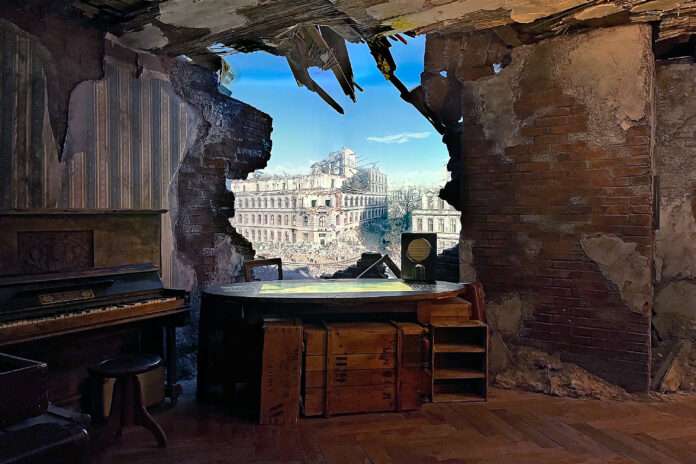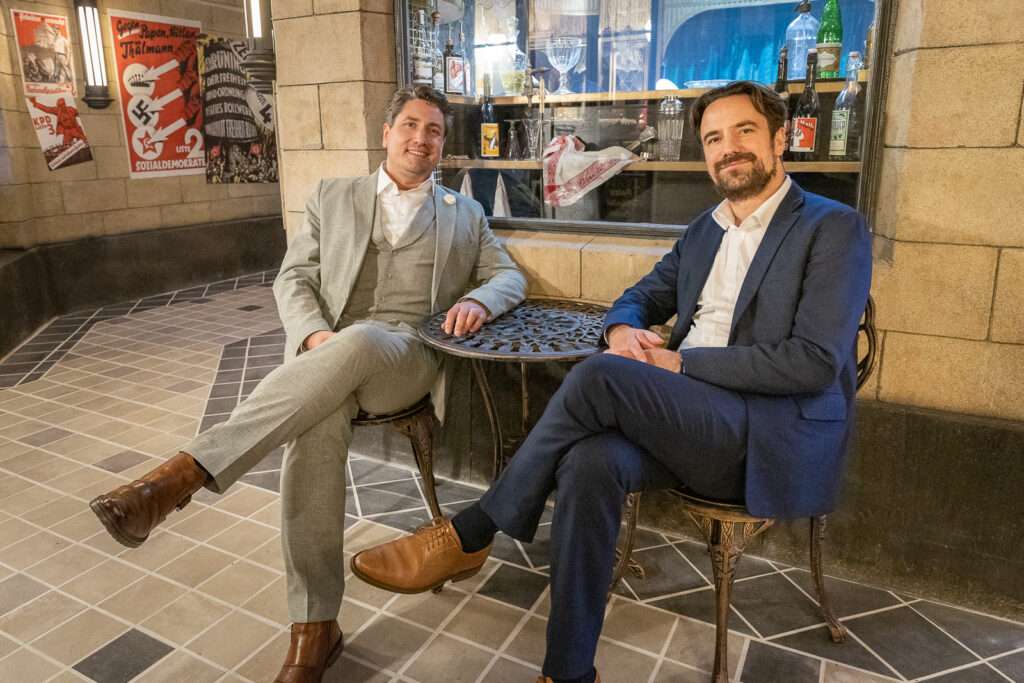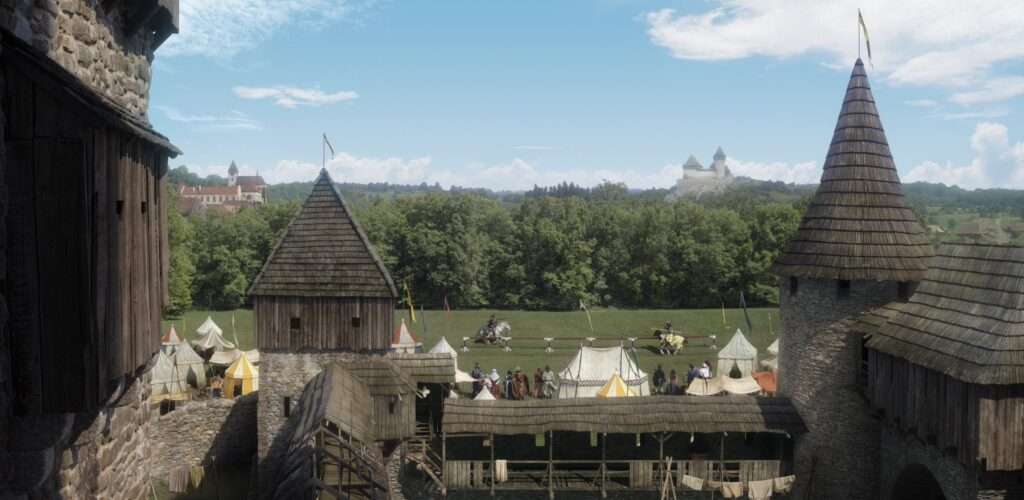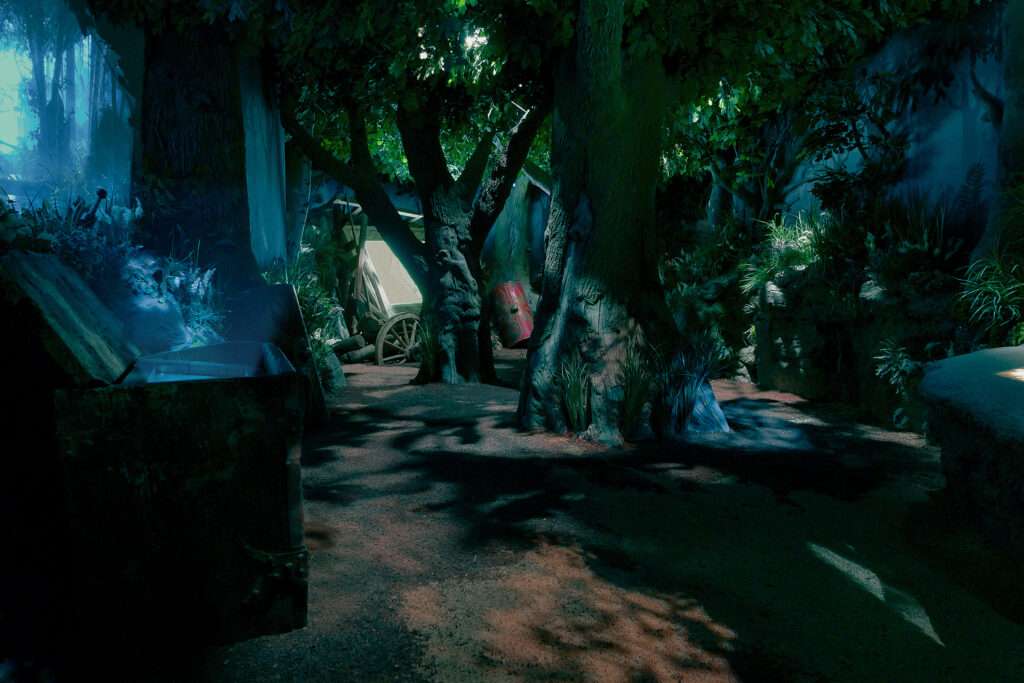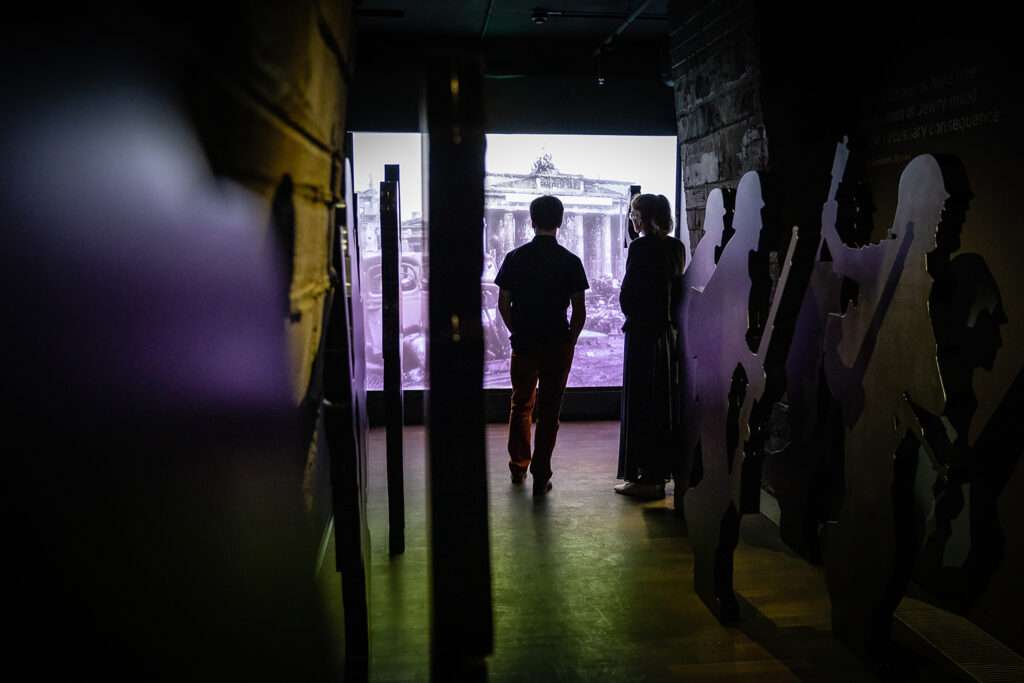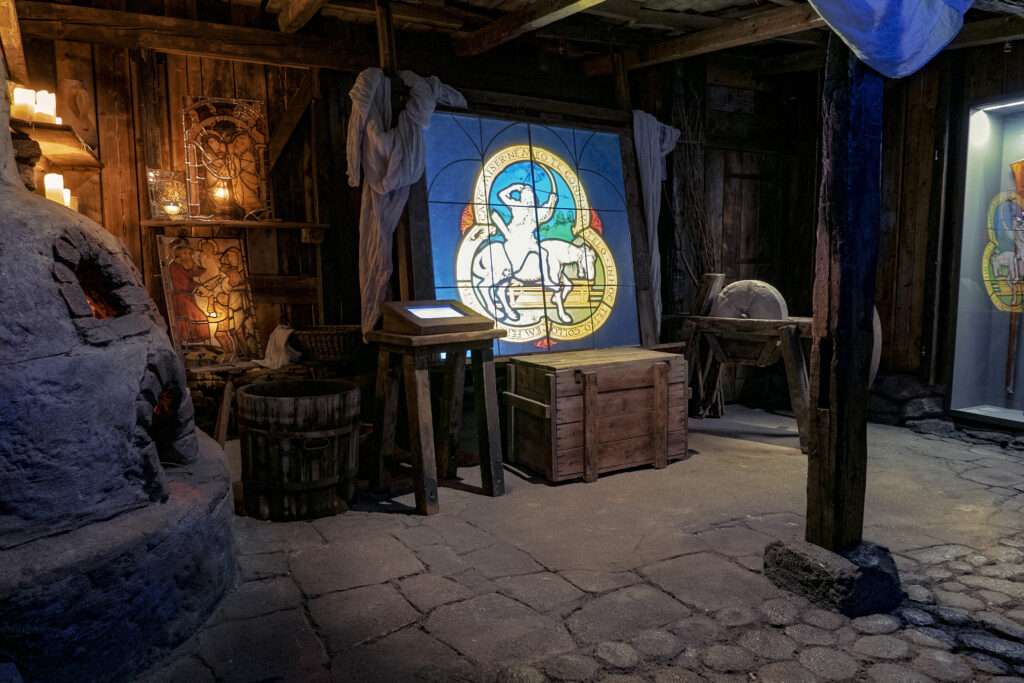Chris Lange explains how Creative Studio Berlin tucked 2,000 years of German history into a one-hour immersive museum experience
interview by Martin Palicki
Honored with a Thea Award for Outstanding Achievement, Deutschlandmuseum opened summer 2023 in Berlin. The compact museum covers 20 centuries of German history in twelve distinct exhibits that immerse guests into fully themed environments, invites them to touch and explore artifacts, and provides opportunities for thoughtful introspection. Creative Studio Berlin Owner Chris Lange worked closely with project owner Robert Rückel on the museum’s design, which was executed in a short ten-month span. Lange went into detail on the museum’s ceiling-to-floor immersive environments and how his team dealt with sensitive issues like the Holocaust while speaking with InPark’s Martin Palicki in advance of the 30th Annual Thea Awards Gala (March 16, 2024).
Why did you want to work on Deutschlandmuseum?
This is really a project close to my heart. I’m German, I live in Berlin and grew up in East Berlin, so I know that part of our history quite well. Though I’ve had the pleasure of working on many different attractions in town, including the Berlin Dungeon and Madame Tussauds Berlin, I was excited to take on a project that focused on Germany’s history. In most projects we are building fantastical worlds where we lean on history only as inspiration to make our own stories and worlds come alive. But here we were relying on real history, and there was great responsibility for how those stories were told. I knew Creative Studio Berlin (CSB) was the perfect company for this project.
Tell us how you became involved in the project.
The owner, Robert Rückel, got in touch with me because he saw the work we did recently at Madame Tussauds Berlin. He was also aware of my work from the Berlin Dungeon, which is also an immersive edutainment experience, though it relies more on actors to convey much of the story. He reached out to one of my old Merlin Entertainments colleagues who oversees the operation of those facilities and then got in touch with CSB.
Do you think those projects influenced his vision for Deutschlandmuseum?
I think they certainly impacted his idea of what you can do with a museum or the way an attraction is designed. He understood that history can be presented in a way that uses storytelling and environment to transport guests back in time.
Also, there are so many outstanding museums in Berlin, including the famous museum of German history with many beautiful artifacts in traditional exhibits. Robert’s vision was to do it completely differently.
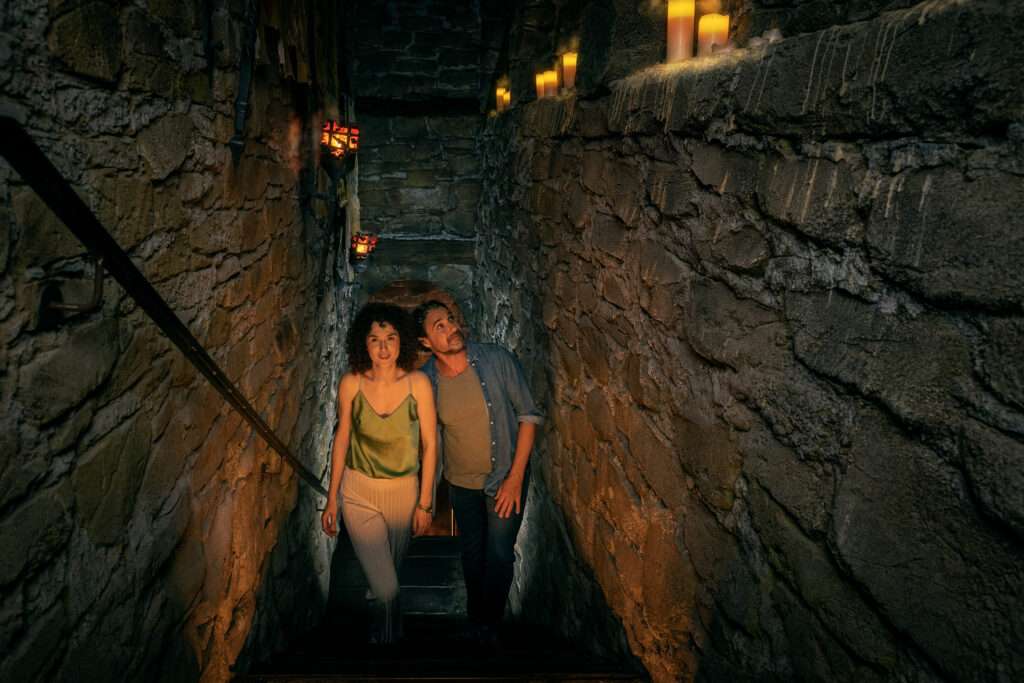
What was your scope of work on the project?
Robert owns the Deutsches Spionagemuseum (German Spy Museum) next door, which has more of a traditional museum format. He already has a team of historians and experts there who he worked with to come up with a rough outline for Deutschlandmuseum. The team had already divided two millennia of German history into certain “chapters” that they wanted to cover in a one-hour experience targeted to tourists, families and school groups. They had identified a starting point of the Teutoburg forest (where Germany was formed). That was the foundation that we used for the start of the design.
Creative Studio Berlin did all the creative work for the museum, designing the 12 different chapters and determining which ones would be immersive spaces (where we themed the walls, ceiling, floors, and even the smells) and which rooms would be abstract spaces (which include more text, interactive displays and more traditional museum exhibition content). We also assembled and managed the team of contractors and specialty vendors that helped fabricate and install the exhibits.
What was the buildout space like?
We were working with an existing building that had hosted exhibitions before, so we had clean walls and nice hardwood floors. When we started, Robert hoped to not have to move any of those walls and to keep all the flooring. But when you start designing you see that certain spaces need to be bigger or smaller. Figuring out the layout was like a puzzle. We had structural columns to work around and two staircases to incorporate. We really tried to make those staircases part of the story and I think it worked out quite well. The first set of stairs leads to the Middle Ages, where you ascend a watchtower and look out over the landscape. The other staircase can be found while exiting an apartment building, walking down to street level. Both staircases are integrated into the scenery and storytelling.
What do you think makes this project special?
If you think about it, we managed to convey 2,000 years of history into twelve different rooms during a one-hour experience that we created and installed in ten months’ time, for less than 5-million Euros. We had to employ a lot of innovative themed entertainment tricks to create this experience. For example, we were extremely limited in ceiling height and had a lot of technology that needed to be hidden. We couldn’t just throw one big projector in to get the scene extensions we needed. Instead, we had to design the space to allow for four smaller projectors.
The media was also really important. Loops have to be just the right length to keep people’s attention but also keep them moving through the museum. And the reset can’t be obvious. In the knight’s tournament you can’t have someone fall off the horse in a battle and then suddenly they are back on the horse to battle again. Our solution was to have people come out and drag that person back into a tent and the horse runs off before the loop resets. It’s those kinds of little details we deal with in theme park and attraction design all the time.
What steps did you take to ensure historical accuracy?
This was absolutely critical. The project historians really held us to a high standard. We made sure that the trees in the forest were accurate to the real site. We would have loved to use pine trees, which would have been nice visually. But they had to be German Oak trees with the right kind of bark on the tree. We also matched the rock and sediment types to what is accurate for that region.
In projects with traditional IP you need to get the owner’s permission for just about everything involving their brand. In this case, history was the IP and our historians were the licensors!
You mentioned that you had immersive and abstract rooms. Can you tell me about the difference and how you came to the right balance between the two?
Deutschlandmuseum has twelve rooms; seven are immersive and five are abstract. The immersive rooms are themed from ceiling to floor. The abstract rooms are more like a traditional exhibition space with cases, artifacts and graphics. Everything we show in the abstract rooms we try to present in a completely different way from how people might experience them elsewhere. For example, the King’s crown, which you can see in the museum down the street, was enlarged and is presented in a way that you can touch it and examine the jewels. We wanted to break the rules of the traditional exhibition case.
We put the abstract rooms between the immersive rooms to give your brain a little bit of rest. From a design viewpoint, it also allowed us to put larger amounts of history into a smaller space. While the immersive rooms represent a specific place or moment in time, the abstract rooms can cover several hundred years of history in one space. I’ve also discovered that if you move from immersive space to immersive space you tend to forget things. But if you break them up with the abstract spaces, people tend to remember the entire journey.
How did you approach the Holocaust?
Obviously, there are other great museums in Berlin that specifically deal with the darker chapter of German history and the Holocaust. We wanted to present it from a different angle that still resonates today. We decided to show how propaganda can motivate people into doing horrible things.
Our solution was to build a labyrinth of human silhouette cutouts. At first you see and hear their muted reactions while listening to a political speech. Then you turn around the corner and the cutouts are more aggressively cheering in support. You turn around the corner again and there are cutouts of soldiers running with weapons. Behind the next corner you see injured people and hear their moans and wails. Since the cutouts are static, the emotion is created by the soundtrack, which had to be handled very delicately.
We also installed direct lighting in the walls that creates long shadows of the cutouts while also making guests feel uncomfortable as it shines directly onto them, like an interrogation.
This is the space I’m most proud of because it was something very new for me, and it delivers on an intensely emotional level. I didn’t want to take a didactic approach saying “Nazis were bad,” because that has been done before. Instead, I wanted people to come to the understanding that the atrocities that occurred were a direct result of how ordinary people acted and reacted. They need to feel uncomfortable and question what they would have done in that situation because – crazily – it all seems to be happening again.
How do you future-proof a history museum?
Our final immersive space takes people into a “S-Bahn” carriage from 1989, when the Berlin Wall came down. As you enter the old train wagon you look at the windows that are screens showing media clips from the mid- to late-20th century. Then you step into the next wagon and it’s a modern car like the ones used today. The screens in there show clips from the 21st century. It’s designed in a way that this media can be updated as needed to keep it fresh and current without having to tear out walls.
You mentioned earlier how theme park design influenced your work on this project. Can you expand on that?
I can condense the experience into three principles that we used on this project that came directly from my work on theme parks:
- Don’t overcomplicate things and use your design language instead of words to tell a story. Use architecture, props and visual cues in a scene instead of a sign. In our first room there’s a shield of a Roman soldier on the ground and there’s blood on it, so it’s pretty clear that he lost the battle.
- Smells help set a mood and scene. Theme parks use scents all the time, but it’s not as popular in museums. In the Deutschlandmuseum we used scents of forest, rotten castle walls, book printing machines, fire, gun powder, cigarettes and more.
- Technology has to be hidden. In traditional museum exhibitions a projector hanging from the ceiling is fine. But in an immersive environment it has to be invisible, along with all the other AV tech and controllers that power the experience. And they have to be seamlessly integrated with the built environment.
Ultimately, you want to create an experience with friends and family that people remember. Those memories stick when they involve things people haven’t seen, heard or experienced before.
What sort of team did you assemble for the project?
I first have to say that Robert, the owner, was such a good partner and willing to take everything to 100%. He always opted to go for the better guest experience. The talented and passionate team here at Creative Studio Berlin was simply fantastic. Our Art Directors Dominik Wieland, Marina Rütten, Oliver Marraffa and Jan Wünsche, our Producer Daniel Rüde and Theming Architect Robert van den Boom worked endlessly to get the project done in those ten months. I also need to recognize the other companies we contracted with who delivered such wonderful work. Our partner Bentin Projects designed the light, audio, video and show technology. Crossworks Projects installed it all. Constantin Bänfer and Jonas Kartenbeck oversaw all graphic and media design. Playing History designed and built the unique interactive elements. Ravir Film produced all video content. And of course, our theming vendors Atelier Thilo Krause and Movie Construction put their heart and soul into every bit of scenery.
How has the response been?
The public response has been phenomenal. But you know what else is really great for us as a company and as a larger industry? This project has gotten so much recognition from the museum community. Clients and owners of other museums have been quite impressed with the museum and now want to use that little bit of theme park magic in their new experiences as well. •


